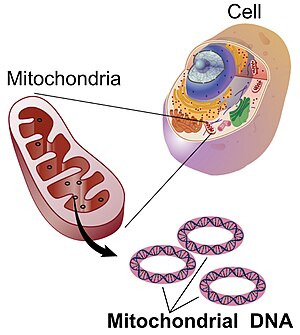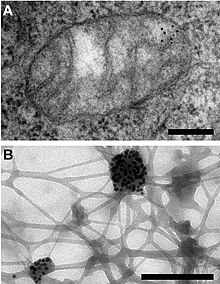مائيٽوڪونڊريل ڊي اين اي


مائٽوڪونڊريل ڊي اين اي (Mitochondrial DNA)، مختصر طور تي ايم ٽي ڊي اين اي (mtDNA) ۽ ايم ڊي اين اي(mDNA)، ڊي اين اي (DNA) آهي جيڪو مائٽوڪونڊريا آرگنيلز ۾ يوڪريٽائ جيو گھرڙن ۾ واقع آهي جيڪو ڪيميائي توانائي کي کاڌي مان ايڊينوسائن ٽرائيفاسفيٽ (ATP) ۾ تبديل ڪري ٿو. مائٽوڪونڊريل ڊي اين اي، ڊي اين اي (DNA) جو ھڪڙو ننڍڙو حصو آھي جيڪو يوڪريوٽڪ جيو گھرڙن ۾ ملي ٿو. گهڻو ڪري ڊي اين اي جيو گھرڙي جي نيوڪلئس ۾ هوندو آهي ۽ ٻوٽن ۽ الجائي ۾ ڊي اين اي پلاسٽڊ، جهڙوڪ ڪلوروپلاسٽ، ۾ پڻ ملي ٿو.[2]
Human mitochondrial DNA was the first significant part of the human genome to be sequenced.[3] This sequencing revealed that human mtDNA has 16,569 base pairs and encodes 13 proteins. As in other vertebrates, the human mitochondrial genetic code differs slightly from nuclear DNA.[4]
Since animal mtDNA evolves faster than nuclear genetic markers,[5][6][7] it represents a mainstay of phylogenetics and evolutionary biology. It also permits tracing the relationships of populations, and so has become important in anthropology and biogeography.
پڻ ڏسو
خارجي لنڪس
 وڪيميڊيا العام تي مائيٽوڪونڊريل ڊي اين اي بابت زمرا
وڪيميڊيا العام تي مائيٽوڪونڊريل ڊي اين اي بابت زمرا
حوالا
- ↑ "The functional organization of mitochondrial genomes in human cells". BMC Biology 2: 9. May 2004. doi:. PMID 15157274.
- ↑ Sykes B. "Mitochondrial DNA and human history". The Human Genome. Wellcome Trust. وقت 7 September 2015 تي اصل کان آرڪائيو ٿيل. حاصل ڪيل 5 February 2012.
- ↑ "Sequence and organization of the human mitochondrial genome". Nature 290 (5806): 457–465. April 1981. doi:. PMID 7219534. Bibcode: 1981Natur.290..457A.
- ↑ Chinnery, Patrick Francis; Hudson, Gavin (June 2013). "Mitochondrial genetics". British Medical Bulletin 106 (1): 135–159. doi:. ISSN 0007-1420. PMID 23704099. PMC 3675899. https://www.ncbi.nlm.nih.gov/pmc/articles/PMC3675899/.
- ↑ "[Not Available]". Génétique, Sélection, Évolution 18 (1): 73–98. 1986-01-01. doi:. PMID 22879234.
- ↑ "Molecular systematics of armadillos (Xenarthra, Dasypodidae): contribution of maximum likelihood and Bayesian analyses of mitochondrial and nuclear genes". Molecular Phylogenetics and Evolution 28 (2): 261–275. August 2003. doi:. PMID 12878463. Bibcode: 2003MolPE..28..261D. https://hal.archives-ouvertes.fr/halsde-00192983. Retrieved 4 November 2018.
- ↑ "Combining multiple autosomal introns for studying shallow phylogeny and taxonomy of Laurasiatherian mammals: Application to the tribe Bovini (Cetartiodactyla, Bovidae)". Molecular Phylogenetics and Evolution 66 (3): 766–775. March 2013. doi:. PMID 23159894. Bibcode: 2013MolPE..66..766H.